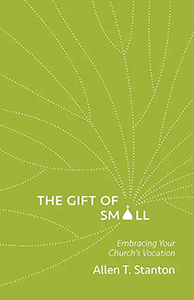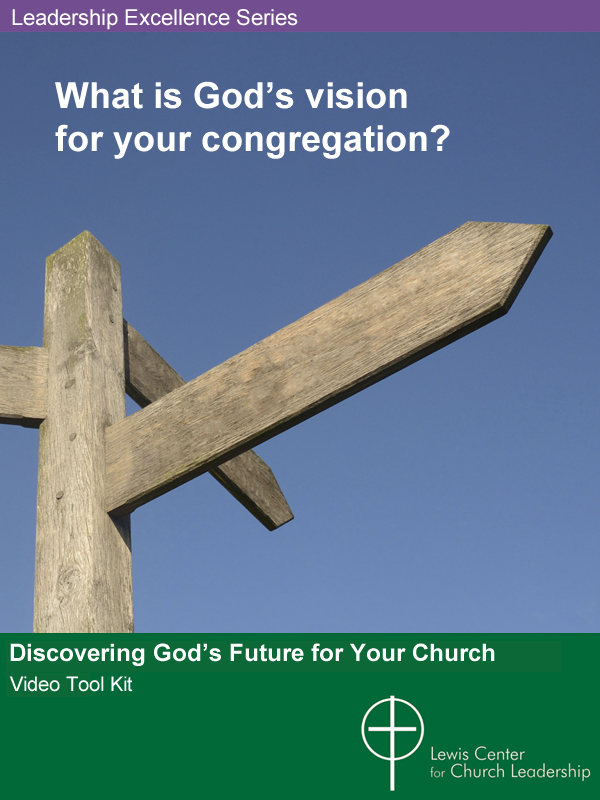In this in-depth interview Allen Stanton explains how small congregations can be surprisingly nimble in the face of change and effective in spiritual formation due to their inherently relational nature.
Ann Michel: In 2021, you wrote a very popular book on building thriving rural congregations. Now, you have a second book, The Gift of Small: Embracing Your Church’s Vocation. Why are you so interested in, even passionate about, smaller congregations?
Allen Stanton: I care a lot about small churches as a person who’s been formed in them. So much of my own spiritual journey has been in small congregations. My own understanding of vocation developed in small churches. I currently attend a small membership church, and I see how it impacts my family. But I also think as our society shifts, as religion and the way that people engage with religion changes, small churches are going to become the norm for how people engage. They’re already the largest number of churches out there. Sometimes we have the idea that small churches are all failing or that they’re bad. But I think they’re doing good work. So, a large part of my passion comes from a desire lift up what small churches are already doing for the Kingdom of God.
Ann Michel: Why do you think the contributions of smaller churches are so often overlooked?
Allen Stanton: I think our theological imagination is a bit misguided. We often think about success only in terms of growth. That ties into how we think about success in other areas of life. In my daily life, I worry about things like the size of my paycheck. There is a cultural proclivity to believe that being bigger is better, and it has seeped into our understanding of what it means to be a successful church. We see this in all sorts of ways. For example, at an Annual Conference gathering, when churches are highlighted for doing meaningful ministry, it is often based on how many programs they have or the amount of money they’re able to spend on programs. The church has bought into the idea that bigger is better, that growth is good, and to borrow a phrase from Jim Collins, “If you’re not growing, you’re dying.” In that, the small church is often overlooked.
Ann Michel: In your book, you discuss the inherent relationality of small churches and how leadership in small congregations needs to be relational leadership. Can you explain your understanding of relational leadership?
Allen Stanton: When I was starting out as a pastor, there was a particular layperson who did so much. She was running the youth group, printing and folding the bulletins, cleaning the church. It seemed like she was in charge of everything that really happened in the church. One day we had a debate about the worship service. I wanted the worship service to be an hour long. But she believed people wouldn’t care if it went longer. It became a tense conversation. I remember reaching out to a mentor who asked me, “What else is happening in her life?” Well, her father had just died, and the church was the place where she had some stability and control at a time when everything in her life was spiraling out of control. I think the small church is really one of the few places where people can come and be themselves and bring all these things to bear. So, a lot of times, relational leadership is just remembering that you’re talking to another human being.
Also, small churches are different organizationally. There are a lot of studies indicating that people engage in small organizations differently than they engage in large organizations. In a large organization, volunteers engage in particular programs. Here in Memphis, for example, St. Jude Children’s Research Hospital sponsors a marathon each year. They have tons of volunteers who come out the day of the run. But they probably won’t serve again until the next marathon rolls around. But in smaller organizations people show up because they are part of making sure that organization stays afloat. They have a vested interest in what happens in that organization. They engage because it is their community where they can be themselves, make friends, and develop deep relationships. When we lead a small church, we’re not leading a hierarchy. We are leading people who exist with a strong relational network.
Ann Michel: What are some of the common pitfalls for incoming clergy when they enter into the life of a smaller congregation?
Allen Stanton: Sometimes people come into a small church and assume it’s a little version of a big church, and that the pastor is going to make a decision and somebody else, perhaps a staff person, is going to carry out the pastor’s directive. But that’s not what happens in a small membership church, largely because you’re not going to have a staff. You need to understand that you’re not in a hierarchical organization and that decisions are going to be made relationally. When a lot of people step into a smaller church, they haven’t figured out how to capitalize on that.
Also, many people assume that small churches can’t change. But small churches can and do change pretty rapidly. In fact, I think they’re quite nimble. For example, in a small church, if you are short a liturgist or a lay reader on Sunday morning, chances are you can find someone else to fill in at the last minute. In my church, we don’t ever have a sure schedule of who passes the offering plates. You just get “volun-told” about five minutes before the service. Because people are committed to the church, they make these pivots all the time.
Ann Michel: You say small churches can change in part because they are so flat, and decisions can be made in a more organic way.
Allen Stanton: Yes. But it has to be done in a smart way that reflects an understanding of the emotional capacity of the congregation. I tell a story in my book of a pastor wanting to replace a decaying, leaking baptismal font. There were people in the church who opposed what seemed like a necessary change. It’s easy to think it’s just because they resist change. But really people were saying, “My grandmother was baptized in that font. My mother was baptized in that font. My daughter was baptized in that font. I was baptized in that font. You’re not going to throw away four or five generations of the history of our faith.” But if you approach the change in a relational way and say, “We need to change this, but how do we preserve that memory?” You’d be really surprised by what can happen.
Ann Michel: You also dispute the assumption that all small churches are aging or dying churches. What do you see in terms of the age dynamics in smaller churches?
Allen Stanton: First, I think it’s important to remember that churches of every size are aging, except for a handful of really large churches. It’s not just small membership churches. Small membership churches are not immune from that decline. In some places, the average age of their members might be a little bit higher than in other places, but that’s normal because the population in their surrounding community is probably also a little bit older. We also have a picture in our heads of small congregations full of people on death’s doorstep. And that’s not true. They’re actually quite diverse in their age and lifespans. Even in a church where a plurality of the people are over 55 or 60, being 55 or 60 in today’s world is very different than being 55 and 60 in the 1930s. You still have a lot of life left at 55 or 60 or 65. So, those can be really active congregations. With people living longer you have a lot of opportunities for intergenerational relationships that might not happen in a larger church where children are just shipped off to a children’s program.
Ann Michel: You have a particular understanding of how faith is formed in smaller communities, in ways that are different than in larger churches. Can you describe what you observe?
Allen Stanton: Churches are places where we learn the habits of what it means to be a Christian. Alistair McIntyre talks about this in terms of our narratives, traditions, and practices. In the small membership church, there are lots of places to practice those things—to remember our narrative and how it ties into what we’re doing, how that tradition ties into the story of who we are, and how all of that points to what we’re supposed to be doing as disciples. Because people engage in small membership churches differently, faith formation isn’t typically happening in programs. But a finance committee meeting becomes a wonderful place to think about what it means to be a Christian embarking on some sort of financial decision. Do we put money in a large bank, or do we put it in this smaller credit union that gives really great loans to people in our community? Small churches have the opportunity to make almost every interaction, whether it’s a finance committee meeting or a trustee meeting, a conversation about what it means to be a Christian making these choices.
Ann Michel: I really appreciate the idea that the work of people who shepherd and steward the church can be spiritually formative because I think there’s a common assumption that committee work isn’t part of Christian formation. You emphasize the sense of belonging in a small church. But the intimacy and familiarity that are strengths of small churches can also make it very difficult for new people to break in. How can smaller congregations make themselves more penetrable and attractive to newcomers?
Allen Stanton: That’s a really great question and I wish I had a great answer for it. I must admit that I hate visiting churches because I never know what I’m going to get. I walk into some small churches and immediately sense that I am not part of the community, and I never will be. I walk into other churches, and I’m overwhelmed by how much attention I get. I think it is helpful to think of the process of engaging a new person as an invitation. And invitations are always two-way. The people in the church have to extend an invitation to whomever new is joining them and ask, “Do you want to be part of us?” And that’s not something that needs to happen the first second they walk in, but as you get to know each other. The newcomer has to come to a place where they say, “Yes. I want to make myself vulnerable and be adopted into this family and commit to this community.” Sometimes we try to make that the very first interaction. But when my family moved to Memphis about a year ago, it took us a long time to find the church we wanted to go to. So, I think you extend that invitation to people as they get comfortable, without overwhelming them. You don’t want to walk in and be told, “Congratulations. You’re now the liturgist for next Sunday.”
Ann Michel: I hear a lot of people say they are either pounced on or ignored when they attend a new church.
Allen Stanton: I find that both of those ways of engaging newcomers are born out of a sense of fear within the congregation. Churches that ignore newcomers are saying, “Well, we’re already on the downward glide. We don’t want anyone else. This is who we are and in 20 years we’ll be dead anyway.” And then the other extreme is, “Oh, thank God! Somebody showed up. We never expected somebody to show up.” And so, they overwhelm you. But churches that are comfortable in who they are usually are the more welcoming. They’re not going to overwhelm you, but they are glad for you to join with them.
Ann Michel: I know that small churches aren’t monoliths. There are lots of different stripes and varieties. What are some of the differences you observe among smaller churches based on their location, denominational heritage, or ethnic identity?
Allen Stanton: From an organizational perspective, churches of less than 100, whether they’re urban or suburban or rural, are going to behave in some of the same ways. But rural churches often have an additional fear of decline because they fear that their surrounding communities are declining as well. So, when I work with rural churches, it’s important to try to understand what’s happening in their community, whether those narratives of decline are true or not, and then how that impacts their congregation. With urban churches, it’s often the opposite where their church has experienced some sort of decline over the last 20 or 30 years. When you go from a church of 400 to a church of 60 it’s a different conversation. With these congregations I see an effort to strip away all the things they thought they were to discern their current vocation. And then suburban churches are often in between. Sometimes these churches are saying, “We thought we would hit it big. There’s a growing population and we thought we would be the next megachurch.” But that didn’t happen. And so, for them it’s getting to a place of understanding what their current mission really is. And sometimes, like rural or urban churches, they have undergone some sort of demographic shift. So, they’re all a little bit different. But once you get beyond the question of “Who are we?” and embrace the notion of being a small church, then I think the behavior starts to match up.
Ann Michel: There are so many churches today that were once large or mid-sized churches that find themselves small because of declining worship attendance. What advice would you give to churches that are growing smaller when that’s not their history or identity?
Allen Stanton: I would say just to embrace their new vocation. What is the vocation of a small membership church? It really is to form disciples. Large churches often do that well, but they do it in very different ways. The question for a smaller church is how can we do this well given our current reality? I don’t want to say they should give up the aspiration of being a larger church, but right now, that’s not really the most important thing. You can grieve it. You can hope that more people will start coming to your church. But it really is about being faithful in the place where God has put you.
Ann Michel: So many of the so-called best practices for church leadership and revitalization emanate from larger churches. Often this advice doesn’t really fit a smaller church’s situation. I wanted to flip the script on that and ask what lessons larger churches can learn from smaller churches?
Allen Stanton: There’s a reason why we romanticize small membership churches in a Hallmark-movie way. It’s not because all small churches are like Hallmark movies, but so many beautiful things happen through the relationships of a small church. Many smaller churches excel in developing a formational community where people learn what it means to be a community of Jesus follower. And if I could just offer one bit of wisdom from the small church to larger churches, it would be to remember that at its core, the Christian community is one of relational discipleship. We are invited to a common table and that is a very vulnerable place to sit. The small church has done that well for a very long time. And we can learn from them how to do it.
The Gift of Small: Embracing Your Church’s Vocation (Fortress Press, 2024) by Allen T. Stanton. The book is available through the publisher, Cokesbury, and Amazon.
Related Resources
- Building Thriving Rural Congregations featuring Allen Stanton — Watch the Leading Ideas Talks podcast video | Listen to the podcast audio version | Read the in-depth interview
- 5 Ways Forward for Very Small Congregations by Lovett H. Weems Jr.
- Fresh Hope for Rural Churches by Jennie Birkholz
If you would like to share this article in your newsletter or other publication, please review our reprint guidelines.








